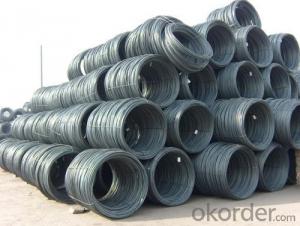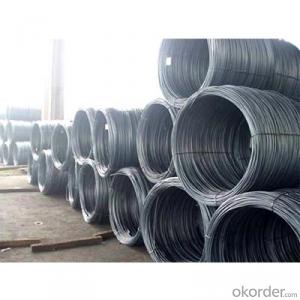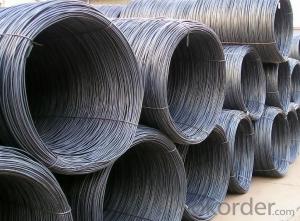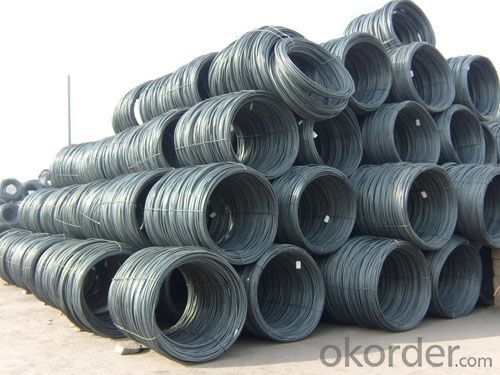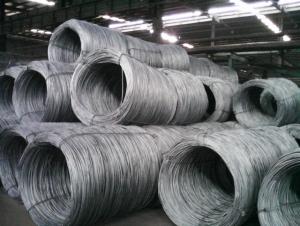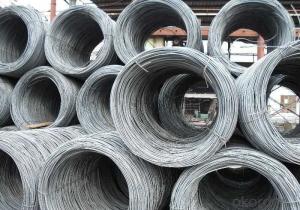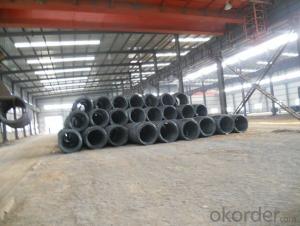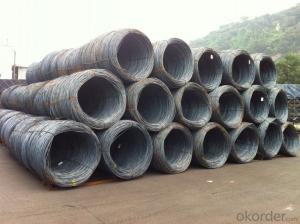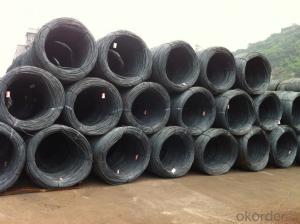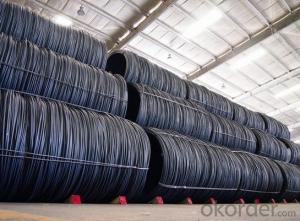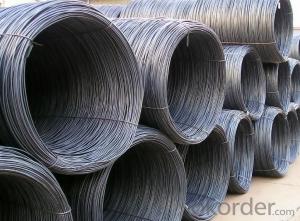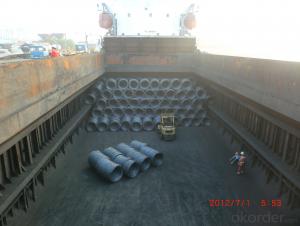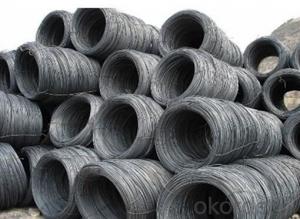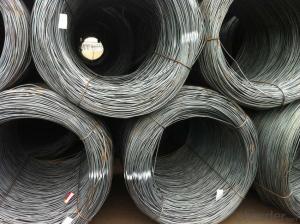Hot Rolled Steel Wire Rod with Good Quality with The Size 8mm
- Loading Port:
- Tianjin
- Payment Terms:
- TT OR LC
- Min Order Qty:
- 50 m.t.
- Supply Capability:
- 20000 m.t./month
OKorder Service Pledge
OKorder Financial Service
You Might Also Like
Hot Rolled Steel Wire Rod with Good Quality with The Size 8mm
Application: Carbon steel wire rod is widely used in construction and manufacturing. Carbon steel wire rod is mainly used for reinforcement of reinforced concrete and welded structure or reprocessed (roberts , nail, etc.) materials, especially used to produce wire drawing, welding electrode, nails, spring, electronic, precise machinery parts and so on.
Features:
Different Sizes: 5.5mm---16mm
Different Material Grade:SAE1006 SAE1008 SAE1010 SAE1012 etc
Packaging & Delivery of Wire Rod SAE1008B:
Packaging Detail: products are packed in coil and then shipped by container or bulk vessel
Each coil weight: 2-3MT
Delivery Detail: within 45 days after received deposit or LC.
Label: to be specified by customer, generally, each bundle has 1-2 labels
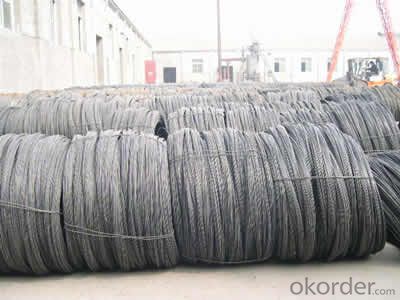
- Q: What are the different types of coatings for steel wire rod?
- There are several different types of coatings for steel wire rod, including galvanized coatings, zinc-aluminum coatings, and epoxy coatings.
- Q: How is steel wire rod used in the production of fencing?
- Steel wire rod is used in the production of fencing as it serves as the main material for manufacturing the wires that create the mesh structure of the fence. The wire rod is first drawn through a series of dies to reduce its diameter and increase its strength, resulting in a thin and durable wire. These wires are then woven or welded together to form the fencing mesh, providing a strong and secure barrier for various applications such as residential, commercial, and agricultural fencing.
- Q: How is steel wire rod used in the manufacturing of wire forms for automotive suspension systems?
- Steel wire rod is an essential component in the manufacturing of wire forms for automotive suspension systems. The wire rod is typically made from high-grade steel and undergoes a series of processes to ensure its strength and durability. Firstly, the steel wire rod is heated and then passed through a series of rollers to reduce its diameter to the desired size. This process is known as wire drawing and helps to improve the wire's surface finish and mechanical properties. Once the wire rod is drawn to the required diameter, it is further processed to enhance its strength and flexibility. This is achieved through a process called heat treatment, where the wire is heated to a specific temperature and then rapidly cooled. This treatment helps to align the steel's crystalline structure, resulting in increased tensile strength and improved ductility. The wire forms used in automotive suspension systems are typically made by bending and shaping the steel wire rod. These wire forms play a crucial role in providing stability and support to the suspension system, allowing it to absorb shocks and vibrations while maintaining the vehicle's balance and ride comfort. The wire forms are used in various suspension components, such as coil springs, torsion bars, stabilizer bars, and control arms. For example, coil springs are made by winding the steel wire rod into a helical shape, which provides the necessary elasticity to absorb and distribute the forces acting on the suspension system. Similarly, torsion bars are made by twisting the steel wire rod, creating a resilient bar that can resist twisting forces. Stabilizer bars, also known as anti-roll bars, are made by bending the wire rod into a U or S shape and then attaching it to the vehicle's suspension system. These bars help to reduce body roll during cornering, improving the vehicle's stability and handling. Furthermore, control arms, which connect the suspension system to the vehicle's chassis, are often made using steel wire rod. These components must be strong and rigid to support the weight of the vehicle and withstand the various forces encountered during driving. In summary, steel wire rod is a crucial material in the manufacturing of wire forms for automotive suspension systems. Its strength, durability, and versatility make it ideal for producing various suspension components that play a vital role in ensuring a smooth and controlled ride for vehicles.
- Q: How is steel wire rod used in the manufacturing of wire for electrical cables?
- Steel wire rod is an essential raw material in the manufacturing of wire for electrical cables. The wire rod is first drawn through a series of dies to reduce its diameter and increase its length, resulting in a fine wire. This wire is then insulated with a non-conductive material, such as PVC or rubber, to create the electrical cable. The steel wire rod provides the necessary strength and conductivity to the wire, making it suitable for electrical applications.
- Q: What are the main factors influencing the choice of steel wire rod order storage tracking options?
- The main factors influencing the choice of steel wire rod order storage tracking options include the size and complexity of the inventory, the level of automation in the storage facility, the frequency of order retrieval and replenishment, the need for real-time visibility and accuracy in tracking, and the overall cost and efficiency of implementing different tracking systems.
- Q: What are the different types of steel wire rod coating processes?
- In the industry, there exist various types of steel wire rod coating processes. These processes aim to offer different levels of protection and enhance the wire rod's performance in diverse applications. Some commonly utilized coating processes comprise: 1. Galvanizing: A layer of zinc is applied to the steel wire rod in this process. Galvanizing delivers exceptional resistance to corrosion and finds extensive use in outdoor applications that expose the wire to severe weather conditions. 2. Phosphate coating: By treating the surface of the steel wire rod with phosphate compounds, a chemical process known as phosphate coating is employed. This coating improves the adhesion of subsequent coatings, such as paint or powder coating, and enhances corrosion resistance. 3. Electroplating: Using an electric current, a thin layer of metal like chromium or nickel is deposited onto the surface of the steel wire rod during electroplating. This process increases corrosion resistance and enhances the wire rod's appearance. 4. Polymer coating: The surface of the steel wire rod is covered with a layer of polymer material, such as PVC or polyethylene, in polymer coating. This coating safeguards against corrosion, abrasion, and chemical exposure, making it suitable for a wide range of applications. 5. Epoxy coating: Epoxy resin is utilized in epoxy coating to create a durable and corrosion-resistant layer on the steel wire rod. This type of polymer coating is commonly employed in applications that require high chemical resistance and mechanical strength. 6. Aqueous film forming foam (AFFF) coating: The AFFF coating is mainly used in fire-resistant applications of steel wire rods. It forms a thin foam layer on the surface, acting as a barrier against heat and fire to protect the wire rod. To ensure optimal performance and longevity of the steel wire rod, it is crucial to select the appropriate coating process based on the specific requirements of the application.
- Q: What are the different physical properties of steel wire rod?
- Some of the different physical properties of steel wire rod include high tensile strength, good ductility, excellent corrosion resistance, high melting point, and good electrical conductivity.
- Q: What are the common defects that can occur during the processing of steel wire rod?
- Some common defects that can occur during the processing of steel wire rod are surface cracks, internal voids or inclusions, uneven dimensions, and incorrect chemical composition.
- Q: How is steel wire rod different from steel bar?
- Steel wire rod and steel bar are both made from steel, but they differ in terms of their shape and size. Steel wire rod is typically a long, thin cylindrical shape with a smaller diameter, often used for various applications such as in the production of wire, nails, and screws. On the other hand, steel bar refers to a solid, straight piece of steel that is thicker and has a larger diameter compared to wire rod. Steel bars are commonly used in construction projects, manufacturing machinery, and as reinforcement in concrete structures.
- Q: What are the safety regulations for steel wire rod manufacturing plants?
- The safety regulations for steel wire rod manufacturing plants vary depending on the country and jurisdiction. However, some common safety regulations include ensuring proper ventilation and exhaust systems to minimize exposure to hazardous fumes, implementing fire safety measures such as fire alarms, extinguishers, and sprinkler systems, providing personal protective equipment (PPE) to workers, conducting regular maintenance of machinery and equipment to prevent accidents, establishing safety protocols for handling and storing materials, and conducting regular safety training and drills for employees. It is important for steel wire rod manufacturing plants to comply with local safety regulations and standards to ensure a safe working environment for all employees.
Send your message to us
Hot Rolled Steel Wire Rod with Good Quality with The Size 8mm
- Loading Port:
- Tianjin
- Payment Terms:
- TT OR LC
- Min Order Qty:
- 50 m.t.
- Supply Capability:
- 20000 m.t./month
OKorder Service Pledge
OKorder Financial Service
Similar products
Hot products
Hot Searches
Related keywords
